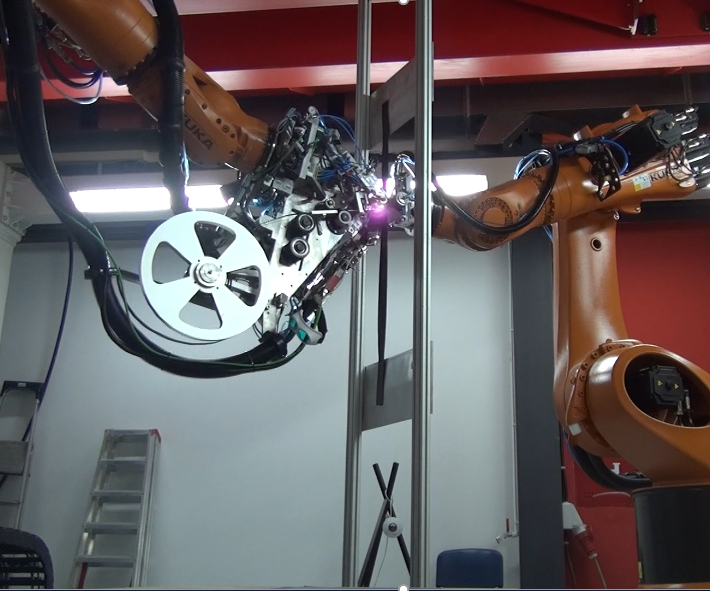General Atomics Aeronautical developing tool-less thermoplastics composites process
Aerospace manufacturer General Atomics Aeronautical Systems Inc. is developing a novel process for the fabrication of thermoplastic composite structures that obviates the need for traditional molds or tooling.

General Atomics' tool-less thermoplastic composites process employs two robots. One (left) applies the carbon fiber/thermoplastic tape. The other (right) provides a movable tooling surface against which the tape is applied.
Aerospace manufacturer General Atomics Aeronautical Systems Inc. (GA-ASI, San Diego, CA, US) is developing a novel process for the fabrication of thermoplastic composite structures that obviates the need for traditional molds or tooling. The system is expected to have application in the aerospace, space, marine and wind energy end markets.
Although it has not been formally named, the tool-less process uses two 6-axis robots working cooperatively to place thermoplastic tape into open space within a metallic or similar frame that provides the boundaries of the structure being fabricated (see photo). Composite Automation LLC (Cape Coral, FL, US), using Mikrosam (Prilep, Macedonia) equipment, worked with GE-ASI to develop the automation.
One robot consists of a standard unidirectional tape placement system that provides laser heating to perform in-situ consolidation of the thermoplastic material. The second “support” robot works directly opposite the automated tape layer (ATL) and consists of a flat metallic surface, providing, in effect, a movable tooling surface against which the ATL places its tape. The tape head and the support head thus move together through 3D space, placing material. Each end of each tape placed is anchored to the frame, which can assume a variety of shapes, depending on the application. Further, the tape can be manipulated by the robotics to change direction within the 3D space to build contoured and complex shapes.
John Geriguis, innovations leader/advanced product development at GA-ASI, has been working with Adam Jones, manufacturing engineering manager, and Paul Sherman, design engineer, on this technology for four years. He says development of the process is ongoing, noting that the company is still working to optimize software systems guiding the robotics. He also says the process is highly dependent on a camera-based in-situ inspection system that detects material and other flaws during the placement process; the system, called real-time virtual assembly tooling (RVAT), developed for GA-ASI by Trilion Quality Systems (King of Prussia, PA, US), is designed to compare the as-manufactured structure with the as-designed CAD data, and then implement tape placement adjustments on the fly to maintain compliance with design specifications.
GA-ASI, says Geriguis, has evaluated several thermoplastic resin systems using the process, including polyetheretherketone (PEEK). However, Geriguis reports that the company has had the most success with Toray’s TenCate Advanced Composites’ (Morgan Hill, CA, US) Cetex TC1225 low-melt polyaryletherketone (PAEK) using a Toray carbon fiber reinforcement.
GA-ASI has applied for a US patent of the process, but Geriguis says this is being done primarily to protect the company’s use of the technology. In fact, says Geriguis, “we hope that others might want to partner and help develop this technology and mature it.”
Interest in the process so far, outside of General Atomics Aeronautical, has come from NASA, which, says Geriguis, sees the potential for its use to build structures in a space environment. He also believes the process could be deployed effectively to fabricate aircraft fuselage and wing structures, as well as wind turbine blades and naval vessels.
Related Content
Carbon fiber in pressure vessels for hydrogen
The emerging H2 economy drives tank development for aircraft, ships and gas transport.
Read MoreMaterials & Processes: Resin matrices for composites
The matrix binds the fiber reinforcement, gives the composite component its shape and determines its surface quality. A composite matrix may be a polymer, ceramic, metal or carbon. Here’s a guide to selection.
Read MoreThe state of recycled carbon fiber
As the need for carbon fiber rises, can recycling fill the gap?
Read MoreComposite rebar for future infrastructure
GFRP eliminates risk of corrosion and increases durability fourfold for reinforced concrete that meets future demands as traffic, urbanization and extreme weather increase.
Read MoreRead Next
CW’s 2024 Top Shops survey offers new approach to benchmarking
Respondents that complete the survey by April 30, 2024, have the chance to be recognized as an honoree.
Read MoreComposites end markets: Energy (2024)
Composites are used widely in oil/gas, wind and other renewable energy applications. Despite market challenges, growth potential and innovation for composites continue.
Read MoreFrom the CW Archives: The tale of the thermoplastic cryotank
In 2006, guest columnist Bob Hartunian related the story of his efforts two decades prior, while at McDonnell Douglas, to develop a thermoplastic composite crytank for hydrogen storage. He learned a lot of lessons.
Read More


























